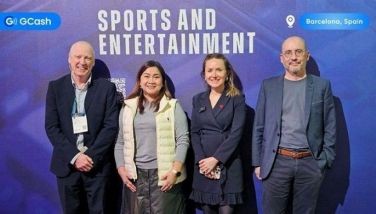Super pen
I’m a comic book geek. And I say that with pride.
I still watch the Batman: Brave and the Bold cartoons. I have bronzed my ratty 1978 Superman: The Movie underwear. And I have a comic book collection that has been growing alongside me before the emergence of my armpit hair.
Some of you may drool over the prospect of meeting rock stars or Hollywood actors or sports icons. But for geeks like me, we soil our adult diapers when we meet the artists of our favorite comic books.
And our adult diapers were soiled to the brim last week when the Canadian artist David Finch, the current artist of DC Comics’ Batman: The Dark Knight, cast the shadow of the bat over Manila.
The 2009 Jose Shuster awardee for outstanding artist (the late Joe Shuster was one of the creators of Superman along with Jerry Siegel) tells us why good comic book art is like a punch in the face, why he is frenemies with many of the Filipino comic book artists, how taking on the mantle of writing and drawing Batman was a humbling experience and why he has a hard time drawing feet.
And, like any good story, David Finch’s superhero story begins with a rejection.
So how did you become such a great artist, David? Was it a mutant power that manifests at adolescence? Was it exposure to radioactive waste? Was it black magic? And if I rub against you in all the right places, will I become a great artist, too?
I was a self-taught artist, which I gather is the same way that the other artists learned their craft. I actually learned in my mother’s basement.
I started off in Top Cow comics where Marc Silvestri was my boss (Comic geek [CG] factoid: Marc Silvestri was a former artist for Marvel Comics’ X-Men who, along with several other prominent artists, put up the breakaway Image Comics back in 1992. Marc’s imprint under Image Comics, Top Cow, produced many successful comics including Cyberforce, Witchblade, The Darkness and Fathom). He’s a phenomenal artist and he taught me everything that I know.
And did you always want to be a comic book artist? Or were you sidelined into comics, similar to DC Comics co-publisher Jim Lee who studied psychology at Princeton before breaking into comics? Maybe you wanted to be hockey player or a mixed martial artist or a lucha libre wrestler when you grew up?
(Laughs) I was a high school dropout. Nothing in school really worked for me. I didn’t know what to do with my life. I never saw being an artist as a (career) possibility, but I loved cartooning. When I found comics, it was an opportunity for me to create worlds on the page. I really wanted to jump into it right away.
I create worlds in my head, too. My wife keeps me on medication because of that. What was the defining comic book that you read growing up that made you say to yourself, “I want to draw comics!”
 Whipping off a quick illustration of Thor
Whipping off a quick illustration of Thor It was old work by that time, but I got into comics with (artist) John Byrne’s X-Men on the “Dark Phoenix Saga” from 1992 (considered a canonical work by many an NGSB comic geek. Elements of this story were incorporated in 2006’s X-Men: The Last Stand). But John’s work didn’t make me want to draw because it looked so polished and clean and perfect. It never occurred to me that I could even draw like John! But when I saw Marc Silvestri’s X-Men work (CG factoid: Marc Silvestri drew The Uncanny X-Men from 1987 to 1990) it was a bit more gestural and loose, so I thought “I could do this!” Then I later found out that it was hard to do that kind of artwork. (Laughs)
If you need somebody whose anatomy is the epitome of gestural and loose, let me know. How did you break into the comic book business?
I did it the same way that most guys did. I put some (art) samples together and brought them to (comic book) conventions. I hit up everybody I could find.
Did they hit back?
I got all the advice I could find (on my artwork) and then went back home and worked on my art. At one point, I actually sent in samples by mail and received a letter from DC Comics that said “I should work on this and this and this.” At first, I thought they had written out those comments specifically (for me). So I worked on every aspect of my art only to find out (later) that it was a form letter. (Laughs) I think my mom still has a copy of the letter.
My mom also kept lot of my rejection letters from the girls I courted in my adolescence. Some of those were form letters, too. Since you’ve already drawn all the major characters for both DC and Marvel Comics, do you plan to move on to work outside of the comic book industry?
I don’t know any other business that gives you a direct line to a fan base who I can show my work to and get a response from. Nowadays, being an artist usually means being a designer and there’s a real removal from any kind of real audience. It means a lot to me to be working for an audience that, by and large, has an appreciation of the work. I love superheroes and I love the more aggressive, darker artwork I can do with superheroes. There aren’t a lot of venues out there for that sort of work. I also love storytelling and it is gratifying to work with great writers.
I love the superheroes, too. If only I could walk around wearing a cape and underwear on the outside of my tights while saving the world from mediocrity. Unfortunately, my wife, my yaya and several public ordinances prevent me from doing so. How would you describe your artwork?
Well, I’ve heard some very derogatory things. (Laughs) But I would describe my style as very dark and tending towards shadow and maybe being a bit more loud and in-your-face and aggressive than some other artists.
And my wife always wonders where I get all my bruises after reading a David Finch comic. Who were your artistic or drawing influences, both inside and outside of comic books?
My number one artistic influence in comics is Marc Silvestri along with the other Image Comics guys like Jim Lee and Todd McFarlane (creator of the anti-hero Spawn). (CG factoid: Filipino-American While Portacio and Batman, Punisher and X-Men artist was one of the co-founders of Image Comics.) Simon Bisely (British comic artist known for his art on another anti-hero character named Lobo published by DC Comics) was a huge influence and my favorite artist. When I broke into the industry, I was really struggling until I went in a “Simon Bisley” direction that really helped me break through. There’s Travis Charest, Kelley Jones, Andy and Adam Kubert, Mike Mignola and Kevin Nowlan. I like so many different styles and I love finding things in different artists’ works and trying to see if I can incorporate it into my own artwork and grow my art from there. Outside of the comic book industry, I love Frank Frazetta. He may not be a comics artist but he is the ultimate comics artist. I love the early American illustrators: J.C. Leyendecker, N.C. Wyeth and Normal Rockwell. My favorite classical painter is Rembrandt. And I’m a huge, huge fan of American impressionist painter Mary Cassatt. The art direction in Blade Runner and the Alien movies and the Star Wars movies have been a big influence for me. Even statues and toys, like Yasushi Nirosawa, I love his sculptures.
 Finch’s work from Batman: The Dark Knight. This piece was actually purchased by a Filipino collector.
Finch’s work from Batman: The Dark Knight. This piece was actually purchased by a Filipino collector. I’m sure you would have also been inspired by the work of Francisco Coching, who was known as the dean of Philippine comics and perhaps our greatest comic book creator. Speaking of Filipino artists, there was a first wave of Filipino artists who drew American comics back in the ‘70s (that’s all part of our plan to take over the world in about 300 years). There were great artists like Alex Niño, Alfredo Alcala and Tony de Zuniga. Did any of these artists influence or inspire your artwork?
I think a lot of great artists have come out of the Philippines. Alex Nino is a very influential artist. It’s almost as if he puts his pencil down and he just draws a whole picture with only one big, long beautiful line. It’s incredible. I’ve got a whole lot of his stuff at home; I finally got to meet him a couple of years ago, it was pretty amazing. I feel like Alex really influenced Frank Miller’s Sin City look.
How about he current crop of Filipino artists?
The biggest name out there right now is Leinil Yu (C.G. factoid: Leinil Yu is a comic book god. He’s drawn X-Men, Wolverine, Avengers and Superman among others. His mere presence causes you to prostrate).
Leinil has a very realistic style. He really knows how to bring so much reality into his artwork, but it’s still “cartooning.” What makes his work so special is that it could be real and tactile but it’s all created from his head.
How about Gerry Alanguilan (award-winning creator of the comic book Elmer), Carlo Pagulayan (Hulk), Harvey Tolibao (DC Comics’ Green Arrow), Stephen Segovia (Wolverine), Mico Suayan (Marvel Comics’ Moon Knight and Thor)?
Every one of them has influenced (my work) and I think part of it is just being competitive (with them). I’m always looking at what’s out there, partly as a fan and partly as someone who has to compete with their work. (Laughs) The artists coming out of the Philippines over the last few years are amazing and are probably the strongest (artists) bloc around.
Does any particular Filipino artist stand out for you?
Mico Suayan. He showed me some mind-blowing work that he is doing in a Batman-related video game over dinner a couple of days ago. It was beautiful to look at and very upsetting at the same time. (Laughs)
From your earlier days drawing Top Cow Studios’ Cyberforce, all the way to your current work on Batman: The Dark Knight, do you feel your artwork style has evolved over the years?
I think the core of what I do always stays there. When I first started drawing comics, I loved the artists that drew really cool anatomy and arms with veins on them. I once read an interview with an artist who said that when he was younger, he used to care about how his anatomy looked. But as he got older, he worried more about page design and not so about the anatomy. When I looked at his work, it showed. I told myself I don’t want to be that guy. I never want to lose sight of the kid that opens a comic and sees a page that jumps out at you and punches you in the face. So it’s that cool-looking figure with an aggressive anatomy.
My wife describes me as having an aggressive anatomy.
I think the most fundamental thing (about being an artist) is the foundations: the proportion of the figure, how dynamic the figure looks, the strength of composition and perspective. Many (aspiring) artists often miss out on the fundamentals. Even if they have some good rendering and really cool designs, if they neglect the fundamentals — your figures look stiff or you fudge on perspective — your work may never get better. The stronger the foundations, the better the artwork. Having said that, even I have some problems with anatomy. For example, drawing a person’s back or feet for me was something that I didn’t study as well as I should have when I was learning to draw. So it remains a weakness for me to this day.
I have problems with some disproportionate parts of my anatomy as well. In the tradition of other artists turned artist-writers like John Byrne and Walt Simonson and Frank Miller, you recently did double duty on a new Batman comic that was produced specifically for you. But then after several issues, you went back to being an artist again.
Yeah It’s like I got stung and then pulled back. (Laughs)
Maybe you were stung by a batarang?
I wanted to try it out. But I was really afraid of coming on to (writing) Batman and doing the kind of “Batman” story that I wanted to do. Although I got across what I wanted to get across, I felt I really missed out on the type of smart story I wanted for the book. I think what is key for me is to work with a writer whom I have the rapport with who can give me a story that is smart and engaging and has heart.
Let me know if you want a story about a self-deprecating Batman who foils villains with one-liners and the able assistance of his yaya dressed as Catwoman, este, Robin. Do you eventually plan to go back to writing or does the bruise from the batarang still sting?
Actually I’m writing something right now, I creator-owned a book that I’ve got mostly written out and I’ve actually started drawing a little bit. I never want to stop writing. I just want to be able to write in a more friendly environment. Don’t get me wrong, though: DC Comics could not have been more supportive (when I wrote Batman). But Batman has 70 years worth of history and there are four Batman comic books that are being published a month that all have to tie together. There’s so much choreography involved that it was a bit too much to take for a new writer who was also trying to draw.
I didn’t realize that Batman had the superpowers of bi-location.
But I really wanted to (write) Batman. And I don’t regret it. I learn from everything that I do, whether it’s a right or wrong move. I never shy away from a challenge. Now I think the challenge for me is to try to establish a relationship with a writer and create something that hopefully will live on.
Perhaps at the start you could have taken on a lesser-known DC Comics character?
That probably would have been a wiser idea. (Laughs)
I hear that the Animal-Vegetable-Mineral Man is looking to break into the big leagues.
* * *
For comments, suggestions or gestural and loose anatomy, please e-mail ledesma.rj@gmail.com or visit www.rjledesma.net. Follow rjled on Twitter.















